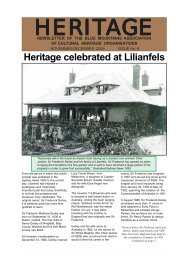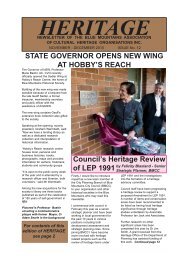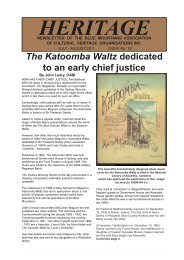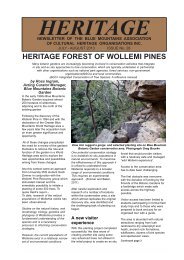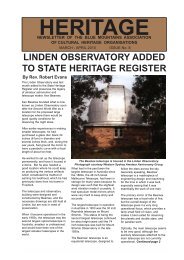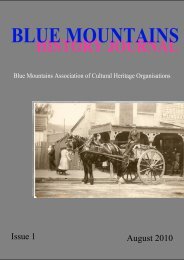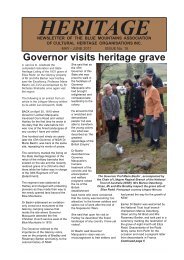Blue Mountains History Journal Issue 3
Blue Mountains History Journal Issue 3
Blue Mountains History Journal Issue 3
You also want an ePaper? Increase the reach of your titles
YUMPU automatically turns print PDFs into web optimized ePapers that Google loves.
<strong>Blue</strong> <strong>Mountains</strong> Historical <strong>Journal</strong> 3; 2012<br />
pp.31-32). In the remainder of this paper I want to suggest that the John Donohoe buried at Linden was<br />
neither soldier, constable nor traveller but, rather, a convict who worked in one of the local iron gangs.<br />
Identifying John Donohoe<br />
It is, I think, somewhat surprising that the possibility of Donohoe being a convict has not previously been<br />
explored. Had he been a soldier/constable his military affiliation would most likely have been included<br />
on the headstone, as it was in the case of Francis Smith, a Lance-Corporal in the 4 th King’s Own who was<br />
transferred from 17 Mile Hollow to the military depot at Springwood in early 1836 and died there later<br />
that same year. While his remains lie somewhere near the present Springwood Police Station, his<br />
gravestone is now in the Springwood Cemetery (Grady 1990; Pollard 2012, p.6). Similarly, Daniel<br />
Collins, a Private in the 28 th North Gloucestershire Regiment, died at 20 Mile Hollow in October 1840<br />
and his headstone with rank and regiment inscribed survives at the Woodford Academy (Medcalf 2005).<br />
It was, also, not unknown for convicts who died while working on the roads to have an inscribed stone<br />
marker placed above their graves. Edgar Church, a young convict buried at Pulpit Hill in 1822, was<br />
granted this mark of respect, the engraved headstone witnessed and transcribed by the French scientist<br />
and explorer Dumont d’Urville during his journey to Bathurst two years later (Duyker & Low 2009,<br />
p.35). In 1843, only six years after Donohoe’s death, another Irish convict, George Conway, died and<br />
was buried at 20 Mile Hollow. Like that of Private Collins, broken pieces of Conway’s headstone survive<br />
at the Woodford Academy (Medcalf 2005).<br />
With far easier access to historical and<br />
genealogical information than was available to<br />
earlier historians, it didn’t take long to confirm<br />
that there was, indeed, a convict named John<br />
Donahue (sic) who died at 17 Mile Hollow in<br />
1837 (State Records n.d. a, Fiche 749, p.57).<br />
He had arrived in NSW on the ‘Earl St.<br />
Vincent’ just before Christmas 1818 (Baxter<br />
1999, p.154), an Irish labourer, quarryman and<br />
well-sinker from Cahir, Tipperary (Figure 6).<br />
Sentenced to ‘life’ for an unspecified crime, he<br />
spent a short period as a ‘servant’ at Windsor<br />
before being moved into ‘government employ’<br />
in Sydney where the 1828 Census records him<br />
residing at the Hyde Park Barracks (State<br />
Records n.d. b, Fiche 640, p.181; Sainty &<br />
Figure 6. Cahir Castle, Tipperary (Valdoria 2006). A Johnson 1985, p.126).<br />
landmark with which Donohoe would have been familiar.<br />
A further question, though, still remained. What had Donohoe done to find himself working in irons on<br />
the <strong>Blue</strong> <strong>Mountains</strong> Road nearly 20 years after his arrival? An ironed convict was generally a recidivist,<br />
one who had committed a further crime in NSW and received an additional sentence from a colonial<br />
court. Again, the answer was soon found with the help of the National Library of Australia’s Trove and a<br />
search of its on-line digital newspaper collection.<br />
In May 1834 John Donohoe, a messenger in the Commissariat Stores (Figure 7), and Adam Sproule<br />
(sometimes spelt ‘Sprowle’ or ‘Sproul’), a sergeant of the 4 th King’s Own Regiment, were charged with<br />
“larceny in the King’s warehouse” (Anonymous 1834b), their trial taking place in August the same year<br />
before Justice James Dowling and a jury of ‘civil inhabitants’. The trial was conducted over the course of<br />
a full day with witness after witness building up the evidence against them. Senior officers and officials<br />
from the military and the Commissariat spoke on behalf of the prisoners but no amount of previous good<br />
character could defend them against having been ‘caught in the act’.<br />
30




